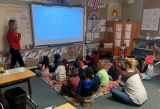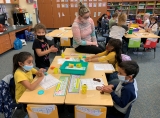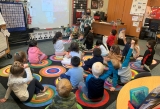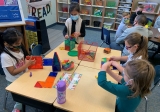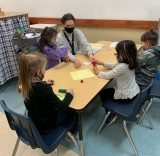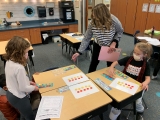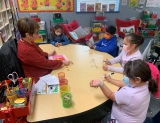-
Category 2
Selected in 2021
-
Grades: pre k - 2
School Setting: rural
Town Population: 3
Student Enrollment: 281
Student Demographics:
Black/African American: 1%
Teacher/Student Ratio: 1:15
White/Caucasian: 34%
Hispanic: 59%
Hawaiian/Pacific Islander: 1%
Asian: 0%
Native American: 4%
Other: 1%
% Reduced Lunch: 54.1%
% ELL Learners: 24.1%
Founded: 1920 -
PRINCIPAL:
Ryne Phillips -
CONTACT:
211 Fourth Avenue
Zillah, WA 98953
509-829-5400
ryne.phillips@zillahschools.org
Hilton Elementary School
Zillah, WA
We keep ALL students' academic and personal success at the core of our decision-making."
- 1. Tell us about your school’s success.
-
Our school success can be attributed to the hard work and dedication of our staff and students. At Hilton Elementary School, we have taken an "all hands on deck" approach to ensuring student success, especially our most at-risk students. We are a team and family here at Hilton Elementary School. Our staff and administration were collaboratively and keep ALL student's academic and personal success at the core of our decision making.
We value the importance of relationships and establishing partnerships with our parents and families. Our staff continues to raise the bar for our students. Through ongoing collaboration, accountability, and the desire to seek continuous improvement...we have achieved great things at Hilton Elementary School. - 2. Talk about the greatest contributing factor(s) that promoted positive change in your school.
-
There have been many instrumental shifts have led to positive change and success in recent years. We have strategically made shifts in our approach to the "whole child" education and to best support all students, especially our most at-risk students.
We revamped our daily schedule to ensure that all students receive "Core and More" in Math and ELA. All students receive daily core instruction in Math and ELA and based on our multi-tiered support system, students receive intervention or enrichment support in Math and ELA.
Our staff has shared responsibility for student achievement, especially for our student subgroups. We utilize common plan time during PLC's to analyze student data and make strategic decisions based on data to support students receiving Tier II and Tier III intervention. - 3. How has ESEA funding supported the school's success?
-
ESEA funding has helped tremendously in our school's success. We have used ESEA funding to hire an Academic Intervention Specialist that focuses on providing Tier III intervention in Math and ELA. We have also used ESEA funding to hire paraeducators that provide Tier II intervention in Math and ELA for all grade levels. Our general education teachers work closely with the paraeducators to provide meaningful and targeted interventions for subgroups of students that need additional support accessing core instruction and meeting standards.
We've also strategically used ESEA funding to hire instructional coaches in Math and ELA to support our teachers during the PLC process. Our goal has been to provide a guaranteed and viable curriculum with common formative and summative assessments that are teachers can use to gather data and drive instruction and intervention support. - 4. What professional development activities were used to improve teaching and learning?
-
Our staff is committed to ongoing professional development. The last few years we have trained teachers to receive Guided Language Acquisition Design (GLAD) certification and use those strategies during instruction because we know it benefits those with English as their second language and those of poverty. We also are committed to providing annual book studies to support staff based on best practice.
The past five years the school has focused on creating intervention supports for different levels of learners while protecting core instructional time. This has developed into a multi-tiered system of support that is naturally driven by staff because it is best for students. Not only does this have a positive impact on student academic success, but also social and emotional success is embedded because individual needs are always addressed. - 5. Talk about the cultural shift leading up to your school's success.
- One of our core values is building positive relationships with students. Developing and maintaining these positive relationships has fostered an environment in each classroom that is highly engaging where students are motivated to do their very best. Our school and teachers have high expectations for all learners and we are very clear about what those expectations are with our students and their families. We want all stakeholders to know that we want to nurture, develop, and improve each child’s overall success. We believe in the whole child approach to education and that we are not just in the business of improving Math and ELA scores, but we are setting the foundation for each child’s future success and growth. One of the biggest shifts in our thinking about our school culture and climate is changing teachers’ thinking from the thought that these are “my” students to the idea that thought that these are “our” students.
- 6. How has community involvement strengthened your success?
- There are many platforms Hilton Elementary uses to engage our families and the community in the success of our school. During our fall and spring parent/teacher conferences we get well over a 95% attendance rate. The Hilton Parent Association has a large number of volunteers and we meet regularly to discuss school-related events, share data about our school performance, and plan ahead for future activities. We have added a parent representative to our School Improvement Team. This has been transformational, as it has given the parents and families in our community a voice about school improvement efforts being made at Hilton. Other opportunities we provide our community to participate in include STEM Nights, Math and Reading Academic Nights, Dad’s Dessert, Mom’s and Muffins, Kids Hope, and many other volunteer programs to support student learning and success.
Stats
-
Category 2
Selected in 2021
-
Grades: pre k - 2
School Setting: rural
Town Population: 3
Student Enrollment: 281
Student Demographics:
Black/African American: 1%
Teacher/Student Ratio: 1:15
White/Caucasian: 34%
Hispanic: 59%
Hawaiian/Pacific Islander: 1%
Asian: 0%
Native American: 4%
Other: 1%
% Reduced Lunch: 54.1%
% ELL Learners: 24.1%
Founded: 1920 -
PRINCIPAL:
Ryne Phillips -
CONTACT:
211 Fourth Avenue
Zillah, WA 98953
509-829-5400
ryne.phillips@zillahschools.org


